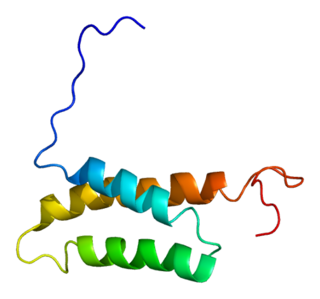Hereditary spastic paraplegia (HSP) is a group of inherited diseases whose main feature is a progressive gait disorder. The disease presents with progressive stiffness (spasticity) and contraction in the lower limbs. HSP is also known as hereditary spastic paraparesis, familial spastic paraplegia, French settlement disease, or Strumpell-Lorrain disease. The symptoms are a result of dysfunction of long axons in the spinal cord. The affected cells are the primary motor neurons; therefore, the disease is an upper motor neuron disease. HSP is not a form of cerebral palsy even though it physically may appear and behave much the same as spastic diplegia. The origin of HSP is different from cerebral palsy. Despite this, some of the same anti-spasticity medications used in spastic cerebral palsy are sometimes used to treat HSP symptoms.

Palmoplantar keratodermas are a heterogeneous group of disorders characterized by abnormal thickening of the palms and soles.

Proteolipid protein 1 (PLP1) is a form of myelin proteolipid protein (PLP). Mutations in PLP1 are associated with Pelizaeus–Merzbacher disease. It is a 4 transmembrane domain protein which is proposed to bind other copies of itself on the extracellular side of the membrane. In a myelin sheath, as the layers of myelin wraps come together, PLP will bind itself and tightly hold the cellular membranes together.

The human gene SPAST codes for the microtubule-severing protein of the same name, commonly known as spastin.

Atlastin, or Atlastin-1, is a protein that in humans is encoded by the ATL1 gene.

Paraplegin is a protein that in humans is encoded by the SPG7 gene located on chromosome 16.

Spartin is a protein that in humans is encoded by the SPG20 gene.

Sacsin also known as DnaJ homolog subfamily C member 29 (DNAJC29) is a protein that in humans is encoded by the SACS gene. Sacsin is a Hsp70 co-chaperone.

Kinesin heavy chain isoform 5A is a protein that in humans is encoded by the KIF5A gene.

Non-imprinted in Prader-Willi/Angelman syndrome region protein 1 is a protein that in humans is encoded by the NIPA1 gene. This gene encodes a potential transmembrane protein which functions either as a receptor or transporter molecule, possibly as a magnesium transporter. This protein is thought to play a role in nervous system development and maintenance. Alternative splice variants have been described, but their biological nature has not been determined. Mutations in this gene have been associated with the human genetic disease autosomal dominant spastic paraplegia 6.

KIAA0196 is a human gene. The product is a protein that is a component of the WASH complex, which regulates actin assembly on intracellular vesicles. Mutations in KIAA0196 are implicated in some forms of hereditary spastic paraplegia.

Spatacsin is a protein that in humans is encoded by the SPG11 gene.

Gap junction gamma-2 (GJC2), also known as connexin-46.6 (Cx46.6) and connexin-47 (Cx47) and gap junction alpha-12 (GJA12), is a protein that in humans is encoded by the GJC2 gene.

AFG3 ATPase family gene 3-like 2 is a protein that in humans is encoded by the AFG3L2 gene.

Fatty acid 2-hydroxylase is a protein that in humans is encoded by the FA2H gene.

Acetyl-coenzyme A transporter 1 also known as solute carrier family 33 member 1 (SLC33A1) is a protein that in humans is encoded by the SLC33A1 gene.
Spastic paraplegia 14 is a protein that in humans is encoded by the SPG14 gene.
Spastic paraplegia 16 is a protein that in humans is encoded by the SPG16 gene.

Zinc finger, FYVE domain containing 26 is a protein that in humans is encoded by the ZFYVE26 gene.
Spastic paraplegia 23 is a 25cM gene locus at 1q24-q32. A genomewide linkage screen has associated this locus with a type of hereditary spastic paraplegia (HSP).















